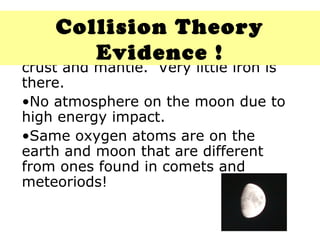Earthlings have entertained many theories about the moon throughout history. The authors suggest that the Moon actually formed inside a giant donut-shaped cloud of molten rock known as a synestia.

Section 4 Pg 488 Earth S Moon Ppt Download
Most of the earlier hypotheses for the Moons origin followed one of three general ideas.

. The sister theorythe Moon formed together with but independent of Earth as we believe many moons of the outer planets formed. Full moons make you crazy. Name and describe the theory that best explains the origin of the moon.
Fission from the earth. What theory best explains the moons origin. The fission theorythe Moon was once part of Earth but somehow separated from it early in their history.
Origin of the MoonBefore the modern age of space exploration scientists had three major theories for the origin of the moon. 2 Show answers Another question on Physics. Quantum mechanics applies to subatomic atomic nanometer-size and micrometer-size systems.
Scientific theorize that a planet-sized object collided with Earth to form the moon. Through history it has had many names. The Moon was formed in another part of the solar system and captured by the gravitational field of the Earth.
Describe the theory of the Moons Origin favored by most astronomers. The thrown off material then became the moon. Nanometer micrometer and kilometer-size systems.
Moon-Density. Impact theory- Idea that a mars sized object hit the earth in a glancing blow. The fission theorythe Moon was once part of Earth but somehow separated from it early in their history.
This hypothesis says that the moon formed when a very large planetesimal smashed into the proto-Earth. This hypothesis says that the moon formed when a very large planetesimal smashed into the proto-Earth. Name and describe the theory that best explains the origin of the moon.
Giant Impact Theory which tells that a very big asteroid namedtheia hit earth in a long time ago resulting a large debris ringwhich later. The Moon is the only natural satellite of Earth. Coaccretion fission and capture.
The Moon and the Earth formed together during the formation of the Solar System. The theory that best describe the moons origin is called the collision-ring theory. A second early idea was that the moon formed somewhere else in the solar system where there was little iron and then was captured into orbit around Earth.
This theory failed because it could not explain why the moon lacks iron. Synestias form when a giant impact puts enough energy into a planet to partially vaporize it and increase its rotation speed. Compare the interior of the moon to that of mercury.
The sister theorythe Moon formed together with but independent of Earth as we believe many moons of the outer planets formed. This shows that the moon formed. Atomic nanometer-size and micrometer-size systems.
Subatomic atomic and. Aug 27 2013. The leading theory of the moons formation posits that it coalesced from material blasted into space when a planet-size body slammed.
This collision would have ejected a disk of debris into orbit around Earth that would have quickly formed the moon. The distance from Earth is about 384400km with a diameter of 3476km and a mass of 7351022kg. One early theory was that the moon is a sister world that formed in orbit around Earth as the Earth formed.
The moon has exactly the same oxygen isotope composition as the Earth whereas Mars rocks and meteorites from other parts of the solar system have different oxygen isotope compositions. Theories on the Origin of the Moon. In this model interstellar nebulae clouds of gas and dust between the stars collapse and.
The Moon was part of the earth and separated from the Earth while the Solar system was in its early stages. Coaccretion suggests that the Moon and Earth were formed together from a primordial cloud of gas and dust. The first detailed theory to explain the origins of Earth and the Solar System in scientific terms was the nebular hypothesis proposed by the Swedish philosopher Immanuel Swedenborg in 1735 and developed by the French mathematician Pierre-Simon Laplace in 1796.
This collision would have ejected a disk of debris into orbit around Earth that would have quickly formed the moon. Other proposed scenarios include captured. Since ancient times full moons.
Most of the earlier hypotheses for the Moons origin followed one of three general ideas. This scenario however cannot explain the. Steve RussellToronto StarGetty Images.
And of course has been known through prehistoric times. Lunar origin theories can be divided into three main categories. Called Luna by the Romans Selene and Artemis by the Greeks.
The origin of the Moon is usually explained by a Mars-sized body striking the Earth making a debris ring that eventually collected into a single natural satellite the Moon but there are a number of variations on this giant-impact hypothesis as well as alternative explanations and research continues into how the Moon came to be. What theory best describes the moons origin.
What Are The Various Theories Of How The Moon Was Formed Quora
What Are The Various Theories Of How The Moon Was Formed Quora

0 Comments